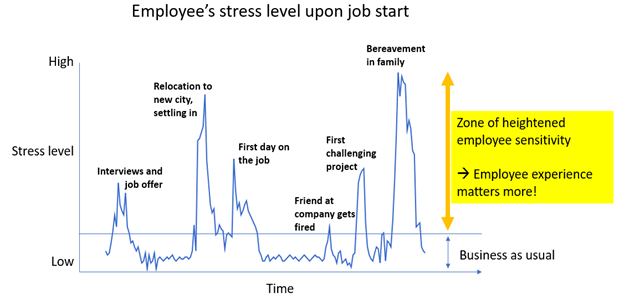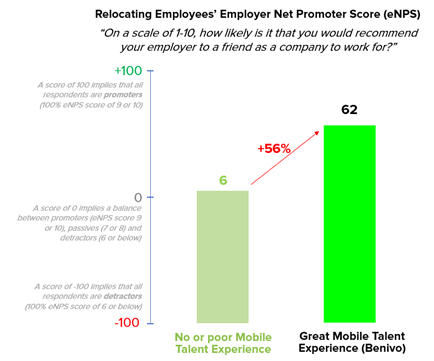We are launching a series of white papers on the topic of Employee Experience.
A company has two most important stakeholders: Its customers and employees.
But while many resources are spent on consumer branding and customer experience, employer branding is, for most companies, not high on the agenda. Even fewer have a systematic approach to it.
We believe that having a system for measuring, managing, and growing your Employee Experience greatly helps your talent acquisition and retention.
And this is what we are trying to do in our Employee Experience Series - to establish a rationale and a system for measuring Employee Experience because it is incredibly important for successful talent management.
The Employee Experience Series contains three white papers:
Why and when companies should care about Employee Experience
In Part 1, we lay the groundwork and discuss why companies should care about their Employee Experience and Employer Brand. We define Employer Brand as the combination of what you promise to employees and to what degree you keep that promise.
Not all shortfalls on the brand promise are of equal importance. The employer brand is the sum of all the individual touchpoints the employee has with the company. And those touchpoints that occur to the employee during a time of stress are of far bigger consequence.
What do we mean by time of stress? Employee stress is induced by both company-triggered events like a promotion, a bad performance review or a relocation for work. But it also emanates from personal circumstances, such as childbirth, sickness, or bereavement. During those times, nerves are raw - and external stimuli are felt more acutely: When you fail to support an employee when they feel vulnerable, it will have a much stronger negative impact than when they are at ease in life and work.

Many such experiences can lead to such erosion of trust that employees will leave, as some of our research shows.
The positive side of the coin is even more important: If you manage to support your employees well during their time of stress, you have the opportunity to sear your brand into their memory and have them associate positive feelings with you.
Given all this, it becomes clear how important it is to implement a robust Employee Experience measuring system. You want to know from your employees, both anonymously and openly, what they think of you so that you can catch negative trends early.
And this is the topic for Part 2 of our series.
How to measure Employee Experience
In Part 2, we make the case for using eNPS (Employer Net Promoter Score) as the single metric to measure Employee Experience.
By asking “How likely is it that you would recommend your employer to a friend as a company to work for? (scale 0-10) ”, you place the employee into a frame of mind that is telling of how they truly perceive you.
But not only because of the question is eNPS the best method. Its scoring system, whereby 0-6 are counted as detractors (who reduce your score), and 7 & 8 count as passives (who don’t add value), is great at focusing the mind on what matters: How can we get 0-6s up into neutral territory, and how can we turn passives into promoters (9-10)?
Finally, we outline a two-lane survey method for taking your employees’ pulse: Lane 1 is an anonymous survey. Lane 2 are personal check-ins with employees during 1-1s with their manager. These two methods, when combined, provide a very robust picture of how your employees perceive you and how this perception changes over time.
But not only that - this method also allows you to test different Employee Experience measures you take, and how satisfied your employees are with your support during critical moments.
One such critical moment is an employee’s relocation - an example we look at closely in the last part of our series.
How to systematically boost Employee Experience and Employer Brand
In Part 3, we look at an example that showcases how a great Employee Experience can, over the course of only a few days, boost the Employer Brand by 60%.
Relocating to a new country to start a new job is one of the most stressful events in anyone’s life, so naturally it is one of the best opportunities to test how a great experience can impact the employee’s perception of the employer’s brand.
We wanted to find out: If an employer gives an employee what we call a great Mobile Talent Experience - how will this influence that employee’s perception of their employer? Can we quantify this effect?
We ran two separate surveys with over 1,000 employees, some of whom received what we consider to be the gold standard of great (but affordable) Mobile Talent Experience - our own Benivo platform which supports them throughout their entire relocation. Others received only a basic version of relocation support, or none at all.
The results from both surveys show remarkably close results: Providing a great Mobile Talent Experience boosts an employer’s Net Promoter Score (and thus Employer Brand) by 60%.

One of our surveys showed a 56% improvement in brand perception when the company used high quality relocation support.The other survey showed a 63% improvement.
This result means two things:
- There are opportunities for outsized returns - which other method that you can implement very easily results in an immediate 60% brand perception boost? Here are a few other ideas for how your can roll out the red carpet for your relocating employees yourself
- You can use this principle - of some experiences having disproportionate impact because they are provided during stressful times - to systematically grow your Employee Experience and, consequently, boost your employer brand.
***
We believe that employers must do more systematic work if they want to differentiate themselves on the talent market - and our White Paper Series on Employee Experience attempts to provide a path to such a system.
Read Part 1 to learn why we think you should care about your Employee Experience, how it is connected to the Employer Brand concept, and why it’s particularly crucial to provide support during stressful times.
Read Part 2 to learn why eNPS is the best measuring method and how you can implement a durable and robust system to continuously tap into the Employee Experience Zeitgeist
Read Part 3 to see an example of outstanding Employee Experience and how it impacts Employer Brand and learn how you can use the underlying concepts to systematically work on your Employer Brand and attract and retain the best talent.
I invite you to read and share your thoughts with us - Either email us directly on feedback@benivo.com or let us know on Twitter.